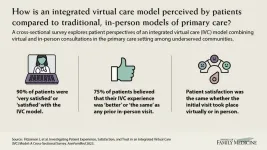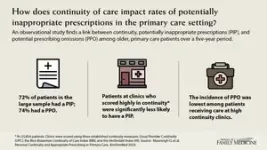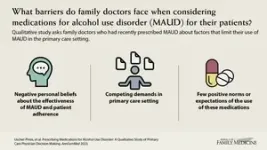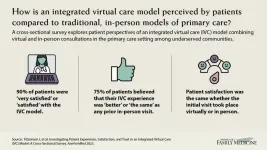In an effort to increase access to care in underserved communities, researchers from the University of Ottawa evaluated the implementation of an integrated virtual care (IVC) model. Their study evaluated the overall experience and satisfaction of patients receiving care through a combination of virtual and in-person visits. A secondary aim was to compare the experiences of patients who had been previously seen in person by a family physician before transitioning to the IVC clinics with those who met their family physician virtually for the first time in their virtual appointment at participating clinics.
The IVC model helps alleviate the burden on overwhelmed primary care clinicians by leveraging telemedicine technology, allowing family doctors located outside the community to provide care to patients remotely. By utilizing secure messaging, telephone consultations, and video appointments, the IVC model expands the pool of available family doctors, ensuring patients can access care even when local clinicians are overburdened. In-person care is provided by physicians, nurse practitioners and other allied health professionals including community paramedics within the local family health team.
Using a cross-sectional online survey administered to 121 patients, the researchers determined that across all groups, 90% of patients were very satisfied or satisfied with care from their family physician, and 89% with care from their allied health team. When comparing previous healthcare experiences, 75% of respondents believe that their encounters with IVC were better than or the same as any prior, in-person healthcare encounters. There was no difference in satisfaction or trust between patients who had a previously established in-person relationship with their doctor and those whose first visit was virtual.
What We Know: Health care systems, both in Canada and globally, have long faced challenges in delivering timely and continuous primary care to their populations. The COVID-19 pandemic further exacerbated these difficulties, prompting health care organizations to establish virtual care networks to address the evolving needs of patients and ensure access to health care services.
What This Study Adds: Researchers found across all groups, 90% of patients were very satisfied or satisfied with care from their family physician, and 89% with care from their allied health team. When comparing previous healthcare experiences, 75% of respondents believe that their encounters with IVC were better than or the same as any prior, in-person healthcare encounters. Those levels were comparable to traditional in-person models of primary care.
Investigating Patient Experience, Satisfaction, and Trust in an Integrated Virtual Care (IVC) Model: A Cross-Sectional Survey
Jonathan Fitzsimon, MD, et al
Faculty of Medicine and Department of Family Medicine, University of Ottawa, Ontario, Canada
Permanent link
Researchers Say Hybrid Telehealth Model Can Help More Hard-to-Reach Adolescents
Researchers in Philadelphia conducted a pilot program to test a hybrid well-visit telehealth model aimed at reaching adolescents who were difficult to reach and had been lost to follow-up. The program involved an initial virtual visit followed by an in-person visit, if necessary. The program focused on a group of 50 patients age 18 with Medicaid insurance who hadn't attended a well visit in over two years and had a history of no-shows. The researchers contacted patients or their caregivers to gauge interest in virtual well visits and initially aimed to fill five telehealth slots over three evenings. However, due to high demand, they expanded the slots to 15. Of the 15 patients scheduled for a telehealth visit, 11 attended the visit (a show rate of 73%), five successfully completed the virtual follow-up, with nine requiring in-person follow-up. The intervention demonstrated a significant impact, resulting in a 40% increase in show rates for well visits compared to the previous average show rate of 33% within this specific patient cohort. For participants who came in for in-person visits, doctors were able to counsel them on substance use and safe sex practices; screen for sexually transmitted infection; write needed medication prescriptions and administer vaccinations. Authors assert that their small pilot shows that a hybrid care model may offer a feasible and acceptable approach across care settings to engage hard-to-reach adolescents in preventive care.
What We Know: Roughly one-half of adolescents have not received a well visit within the past year, resulting in missed opportunities for primary care clinicians to provide important health services for this population. Despite the support from the American Academy of Family Physicians and the American Academy of Pediatrics, there has been limited exploration of a hybrid care model specifically designed for adolescent preventive care.
What This Study Adds: Adolescent patients previously lost to follow-up responded positively when offered the opportunity to participate in a virtual well visit. Results suggest that pre-visit outreach could be an essential tool to ensure that adolescents complete well visits, which afford an important opportunity for family doctors to provide important preventive care services.
Meeting Adolescents Where They Are: Hybrid Virtual-in-Person Visits for Routine Preventive Care
Brian P. Jenssen, MD, MSHP, et al
Department of Pediatrics, Perelman School of Medicine, University of Pennsylvania;
The Possibilities Project, Clinical Futures, and PolicyLab, Children’s Hospital of Philadelphia; Department of Biomedical and Health Informatics, Children’s Hospital of Philadelphia, Philadelphia, Pennsylvania
Permanent link
Navigating Telemedicine Implementation: Exploring Experiences of Primary Care Clinicians Early in the COVID-19 Pandemic
Researchers from Virginia Commonwealth University and Case Western Reserve University conducted weekly and monthly surveys of primary care clinicians to examine the use of telemedicine during the COVID-19 pandemic. The e-surveys were conducted between March 2020 and March 2022 and used convenience sampling. A total of 36 surveys were completed, with an average of 937 respondents per survey, representing clinicians from all 50 states and from multiple specialties.
Initially, respondents reported difficulties in implementing telemedicine, citing challenges with infrastructure and reimbursement mechanisms. However, as time progressed, attitudes toward telemedicine became more positive, and clinicians recognized video- and phone-based care as valuable tools in their practice – though not a complete substitute for in-person care.
What We Know: The COVID-19 pandemic compelled health care staff to rapidly adopt telemedicine tools to ensure continued care while prioritizing patient safety. Medical personnel encountered several challenges during the early stages of adopting telehealth models of care, including limited access to infrastructure for conducting consultations, issues with reimbursement rates for telemedicine services, the necessity to redesign workflows, and the need for comprehensive training.
What This Study Adds: Although there were initial implementation challenges during the pandemic, primary care professionals now recognize the advantages of integrating telemedicine into their practices and view technology as a valuable complement to their care delivery. However, researchers assert that their survey findings on the adoption and utilization of video- and phone-based care during the pandemic help identify potential obstacles, including implementation barriers and payment methods.
Telemedicine in Primary Care: Lessons Learned About Implementing Health Care Innovations During the COVID-19 Pandemic
Rebecca S. Etz, PhD, et al
Larry A. Green Center for the Advancement of Primary Health Care for the Public Good;
Department of Family Medicine and Population Health, Virginia Commonwealth University, Richmond, Virginia
Permanent link
Researchers Examine the Impact of Loan Repayment Program Enrollment on Physician Workforce Equity and Patient Care Access
Researchers from the American Board of Family Medicine and the University of Minnesota Medical School investigated whether participation in medical school repayment programs impacted the care family physicians provided to patients post graduation. By analyzing data from over 10,000 American Board of Family Medicine National Graduate Survey respondents, the authors examined differences in program participation, participant demographics, scope of practice, and the likelihood of serving medically underserved or rural populations.
The study revealed a significant increase in participation in the Public Service Loan Forgiveness (PSLF) program between 2016 and 2020, while participation in the National Health Service Corps (NHSC) program remained unchanged. Physicians enrolled in the NHSC program were more likely to come from underrepresented groups; exhibited a wider scope of practice; and were more inclined to practice in rural areas (23.29% compared to 10.84% in PSLF). They also were more likely to practice in areas designated as Health Professional Shortage Areas (12.5% compared to 3.70% in PSLF), serving medically underserved populations (82.17% compared to 24.22% in PSLF). In contrast, PSLF primarily supported physicians intending to work in public service.
What We Know: With average medical school debt soaring to $200,000 over the last few decades, the escalating financial burden is driving concerns that students may opt out of low-pay but high-value public service careers in Federally Qualified Health Centers (FQHCs), rural health clinics, and the Indian Health Service. Loan repayment programs – like the Public Service Loan Forgiveness program and the National Health Service Corps (NHSC) – play a vital role in making primary care a viable career option by alleviating the burden of high educational costs.
What This Study Adds: The analysis conducted in this study suggests that PSLF may be less effective in supporting family physicians from underrepresented backgrounds, promoting a broader scope of practice, and directing physicians to underserved settings compared to service-based loan repayment programs like NHSC.
Impact of Service-Based Student Loan Repayment Program on the Primary Care Workforce
Caitlin S. Davis, MD, MSc, et al
Fairfax Family Medicine Program, Fairfax, Virginia
Permanent link
Family Medicine Physicians Receive Lowest HPV Vaccine Cost Reimbursements Compared to Pediatricians, Internal Medicine Doctors, Nurse Practitioners and Other Specialists
Human papillomavirus (HPV) vaccination coverage has improved in the United States, but privately insured adolescents have lower initiation and completion rates compared to those under public insurance programs. One of the contributing factors to this disparity is the higher cost of the HPV vaccine compared to other routinely recommended adolescent vaccines. While private payers typically reimburse the cost of the HPV vaccine at or above the CDC list price (i.e., $210.99 in 2017-2018), it remains below the American Academy of Pediatrics' recommended price (i.e., $263.74). Adequate reimbursement for vaccine costs by third-party payers plays a critical role in enabling doctors and other medical staff to offer and continue providing vaccines.
Researchers investigated the reimbursement rates for HPV vaccine costs across various medical specialties, including pediatricians (as the comparison group), family physicians, internal medicine specialists, nurse practitioners, and other medical practitioners. Additionally, they examined whether the reimbursement amounts were associated with the number of HPV vaccine doses administered by these health care practitioners.
The study analyzed data from over 34,000 unique practitioners and found that family physicians had the lowest net returns per dose ($0.34), while pediatricians had the highest returns ($5.08). On average, during 2017-2018, pediatricians received higher reimbursement for HPV vaccine costs ($216.07) compared to family physicians ($211.33; p<0.0001), internists ($212.97; p<0.0001), nurse practitioners ($212.91; p<0.0001), and 'other' practitioners ($213.29; p<0.0001). The researchers also observed that a one-dollar increase in return was associated with a slight increase in HPV vaccine doses administered, particularly among family physicians (0.08% per dollar). Although reimbursement for HPV vaccine costs by private payers is considered adequate, according to the authors, the study highlights that non-pediatric specialties have a very marginal return on investment, which may be insufficient for covering indirect expenses for stocking vaccines (storage cost, personnel cost for monitoring inventory, insurance, waste, and lost opportunity costs). The authors argue that this makes them more sensitive to changes in cost reimbursement, emphasizing the need for an increase in reimbursement rates for these practitioners so that they can continue offering the cancer-preventing HPV vaccine.
What We Know: The human papillomavirus (HPV) vaccine is the most expensive of all routinely recommended pediatric vaccines. Adequate cost reimbursement by third-party payers is important for helping practitioners continue to offer the vaccine.
What This Study Adds: Researchers determined that net returns from HPV vaccine cost reimbursements are lowest for family physicians ($0.34/dose) and highest for pediatricians ($5.08/dose). Furthermore, a one dollar increment in return was associated with an increase in HPV vaccine doses administered (highest for family physicians; 0.08% per dollar). Although reimbursement for HPV vaccine costs by private payers is generally adequate, according to the authors, non-pediatric specialties face very marginal returns on investment. The authors argue that specialties with narrow returns are highly sensitive to changes in cost reimbursement, and therefore, are worthy of increased reimbursement.
Reimbursement for HPV Vaccine Cost in the Private Sector: A Comparison Across Specialties
Kalyani Sonawane, PhD, et al
Department of Public Health Sciences, College of Medicine, Medical University of South Carolina, Charleston, South Carolina
Permanent link
Primary Care Doctors Face Barriers in Treating Alcoholism
Researchers explored how primary care physicians who have some familiarity with medications for alcohol use disorder (MAUD) make prescribing decisions and identify reasons for the underuse of MAUD in primary care. They interviewed 19 primary care physicians who had recently prescribed MAUD to patients in an outpatient setting. These physicians were selected from a large online database of medical professionals. Participating physicians reported several challenges in prescribing MAUD: (1) they had somewhat negative personal beliefs about the effectiveness of medications and the likelihood of patient adherence; (2) they faced competing demands in primary care that made prescribing medications a lower priority; and (3) there were few positive norms or expectations regarding the use of these medications. To make MAUD prescribing a smaller component of their practice, physicians followed certain "rules of thumb" to select specific patients for these medications. These included recommending the medications to patients who seemed the most motivated to reduce drinking; those with the most severe AUD; and those who were also receiving other treatments for AUD.
What We Know: Over 29 million Americans have alcohol use disorder (AUD), according to the 2019 National Survey on Drug Use and Health. Although there are effective medications for AUD and can be prescribed within primary care, they are prescribed to only a fraction (8.7%) of people with the disorder. Primary care doctors face barriers to prescribing these medications more often.
What This Study Adds: Researchers identified barriers faced by primary care physicians in prescribing medications for alcohol use disorder, including negative beliefs about medication effectiveness and patient adherence, competing demands in primary care, and limited positive norms. Primary care doctors are also selective about which patients they prescribe medications to so that this remains a smaller part of their practice. The authors call for increased focus on the study and development of standardized selection requirements to initiate MAUD.
Prescribing Medications for Alcohol Use Disorder: A Qualitative Study of Primary Care Physician Decision Making
Lori Uscher-Pines, PhD, et al
RAND Corp, Santa Monica, California
Permanent link
Primary Care Clinics that Improved Patient Access, Identified At-Risk Patients and Expanded Services Experienced Reductions in Acute Hospitalizations
Researchers from Mathematica studied high-performing Comprehensive Primary Care Plus (CPC+) sites to identify key strategies that contributed to significant reductions in acute hospitalization rates. Researchers identified CPC+ practice sites with the highest likelihood of achieving substantial reductions in Medicare acute hospitalization rates between 2016 and 2018, and referred to them as "Acute Hospitalization Rate (AHR) high-performers." Afterwards, they conducted telephone interviews and within- and cross-case comparative analyses of 14 of these primary care practice sites, with the help of physicians, practice administrators, care managers, and other practice staff including nurses and pharmacists.
AHR high-performers credited various care delivery activities that aligned with three key strategies: (1) improving and promoting timely access to primary care, (2) identifying high-risk patients and providing enhanced care management tailored to their needs, and (3) expanding the range of services offered at the practice site. The AHR high-performers also recognized several factors that facilitated the implementation of these strategies, such as receiving enhanced payments through CPC+, prior experience in transforming primary care practices, utilizing data to identify valuable activities for specific patient subgroups, fostering teamwork, and benefiting from organizational support for innovation. Based on their findings, the researchers concluded that strengthening the local primary care infrastructure through practice-driven and targeted changes in access, care management, and comprehensiveness can support efforts to reduce incidence of acute hospitalizations. They encourage other primary care clinics to emulate these strategies, tailoring specific activities to fit their context, personnel, patient population and available resources.
What We Know: Access to timely primary care has been linked to reduced hospitalizations among patients. However, the existing health care system often lacks the necessary resources to enable primary care doctors to reach patients before their conditions worsen and require hospitalization. Notably, clinics enrolled in CMS’ Comprehensive Primary Care Plus (CPC+) program receive both financial and technical support to proactively engage with patients prior to hospitalization. However, researchers aren’t certain what high-performing clinics are doing to reduce acute hospitalization rates. Petersen, et al’s study strives to explain those specific activities.
What This Study Adds: Clinics that successfully reduced acute hospitalization rates implemented several effective strategies. They focused on improving access to primary care, proactively identifying high-risk patients and providing them with enhanced care management. These clinics also expanded the range of services available to patients. Additional contributing factors to their success included receiving enhanced payments through CPC+, prior experience with clinic transformations, utilizing data to identify high-value services for specific patient groups, receiving organizational support for change, and fostering teamwork among health care professionals.
Reducing Acute Hospitalizations at High Performing CPC+ Primary Care Practice Sites: Strategies, Activities, and Facilitators
Dana M. Petersen, MA, MPH, PhD, et al
Mathematica, Oakland, California
Permanent link
Geriatrics and Supportive Care Practice Utilizes Community-based Help to Treat Vulnerable Patients During the COVID-19 Pandemic
During the COVID-19 pandemic, clinicians from The University of Texas Health Science Center at San Antonio Geriatrics and Supportive Care Practice accompanied health promotorés from a local non-profit organization on home visits to patients following the challenges with telehealth and lack of access to technology among the underserved populations due to cancellation of in-person visits due to the pandemic. In addition to addressing a patient’s immediate medical concerns during home visits, the clinician-promoter teams collaborated to provide follow up services and connect patients with community resources informed by social determinants of health. Teaming health promotorés with clinicians increased in-home visits to homebound patients from over 3,000 visits to nearly 7,000 visits (229%) in several underserved ZIP codes in Bexar County, Texas. The team also increased access to homebound persons with dementia who would have otherwise relied on emergency care.
Between 2021 and 2022, there was a significant decline in inpatient admissions and emergency room visits, dropping from 490 to 411 per 1,000 persons (a reduction of 17%) and from 920 to 830 (an 11% reduction), respectively. Moreover, the costs of care decreased by approximately $3,000 per member per year for participants, which can be attributed to the accountable care organization. In addition to these improvements, patient satisfaction levels jumped from 92% to 98.5% based on data from 343 individuals. Based on these positive outcomes, the authors assert that the collaborative efforts of clinicians and promotorés (CHW’s) enable the provision of a comprehensive array of cultural, medical and health services that effectively address social determinants of health.
What We Know: The COVID-19 pandemic prompted the closure of community-based primary care clinics, leaving vulnerable populations without access to essential health care services. In response, health organizations such as The UT Health Science Center San Antonio Geriatrics Care clinic navigated unique challenges and adopted innovative approaches to connect with patients, particularly older and low-income individuals who encountered obstacles like technology limitations and language barriers.
What This Study Adds: By joining health promotorés on their home visits, clinicians expanded their outreach to the community, helping patients continue routine health services during ongoing closures of facilities brought on by the COVID pandemic.This collaborative effort contributed to a notable reduction in both inpatient and emergency room visits, alongside a decrease in health care costs. In addition, patient satisfaction increased from 92% to nearly 99% between 2021 and 2022. In light of these positive outcomes, the authors assert that the combined efforts of clinicians and health promotorés enable the delivery of a broader range of culturally sensitive medical and care services, effectively overcoming social determinants of health and psychosocial barriers.
Clinicians and Promotorés Teaming to Provide In-Home Primary Care to Frail Older Adults
Neela K. Patel, MD, MPH, CMD, FAAFP, et al
The Department of Family and Community Medicine, The University of Texas Health Sciences Center at San Antonio, and the Glenn Biggs Institute for Alzheimer’s and Neurodegenerative Diseases – South Texas Alzheimer’s Disease Research Center, UT Health San Antonio, San Antonio, Texas
Permanent link
Greater Primary Care Continuity Among Older People is Associated with Fewer Inappropriate Prescriptions and Prescribing Omissions
Researchers from the Netherlands conducted an observational study to determine the association between personal continuity and potentially inappropriate prescriptions (PIPs) by family physicians in older patients. PIPs can be categorized as potentially inappropriate medications (PIMs) and potential prescribing omissions (PPOs). The study utilized anonymized routine care data from 269,478 patients, receiving care in 48 Dutch family practices, from 2013 to 2018. They included all patients 65 and older with five or more contacts with their practice in six years, giving them a sample of 25,854 individuals. Personal continuity was measured using three established indices: Usual Provider Continuity (UPC); the Bice-Boxerman Continuity of Care Index (BBI); and the Herfindahl Index (HI). The prevalence of PIPs were determined using screening tools. To assess the association, they conducted analyses with and without adjustment for number of chronic conditions, age and sex.
Higher scores in BBI, HI and UPC were associated with a significant reduction in potentially inappropriate prescriptions. Within the UPC, BBI and HI measures, the mean personal continuity was 0.70 (0.19), 0.55 (0.24) and 0.59 (0.22), respectively. Among more than 25,000 patients the researchers examined, 72.2% and 74.3% had one or more potentially inappropriate medications (PIMs) or PPOs, respectively; and 30.9% and 34.2% had three or more PIMs or PPOs, respectively. The authors conclude that higher personal continuity is associated with more appropriate prescribing and argue that increasing personal continuity may improve quality of prescriptions and reduce harmful consequences.
What We Know: Prescription management is an important aspect of primary care for older patients as inappropriate prescribing can result in avoidable adverse events such as hospitalizations, falls and acute kidney injury.
What This Study Adds: Researchers found a significant association between increased rates of primary care continuity, as measured by three indices, and a decrease in potentially inappropriate prescriptions (PIPs) among primary care patients. For potentially inappropriate medications (PIMs), this effect was only observed in the patient group with five to 18 chronic conditions compared to the groups with fewer chronic conditions.
Personal Continuity and Appropriate Prescribing in Primary Care
Otto R. Maarsingh, MD, PhD, et al
Amsterdam UMC location Vrije Universiteit Amsterdam, Department of General Practice, and Amsterdam Public Health Research Institute, Vrije Universiteit, Amsterdam, The Netherlands.
Permanent link
Survey Suggests Geographic Inequalities in Patient Registration versus Primary Care Physician Density Can Exclude Patients from Comprehensive Care Access
French researchers conducted a large, simulated study to examine the relationship between the presence of primary care physicians (PCPs) and the ability of patients to register with a PCP. The study aimed to analyze local PCP supply based on various indicators, including PCP presence, patient registration availability for office visits, and patient registration availability for home visits. Out of 5,188 census blocks, 55.4% had at least one PCP, with 38.6% of those blocks allowing registration for office visits and 19.46% allowing registration for home visits. The research revealed that geographic inequalities in patient registration were more significant than those related to PCP density, challenging the assumption that patients could easily find and register with a PCP. They found that doctors were less likely to accept new patients who required time-consuming procedures including home visits and complicated services. Additionally, they were also less likely to accept new patients if they worked in areas that required them to take on the highest work loads (lowest PCP density in the most disadvantaged areas). The authors argue that policy decisions mandating patient registration with a PCP to access health care may unintentionally exclude individuals who are unable to register with a PCP, preventing them from benefiting completely from the health care system.
What We Know: Finding a PCP with whom to register in France is a prerequisite for benefiting fully from the health care system, access to which can be undermined by substantial PCP refusal to register new patients. PCPs can also refuse appointments to unregistered patients.
What This Study Adds: The findings from the study suggest that the number of primary care doctors in a specific area does not correlate with a patient’s ability to register for care from any of those doctors. Patients who requested more complex services or were located in more disadvantaged areas were more likely to be denied registration for a PCP. The researchers contend that the inability of patients to register with a PCP may result in the exclusion of certain patient groups from accessing health care services that require PCP registration. These observations highlight the need for a more nuanced approach in developing policies to ensure equitable health care access for all individuals.
Presence of Primary Care Physicians and Patients’ Ability to Register: A Simulated-Patient Survey in the Paris Region
Raphaëlle Delpech, MD, et al
Department of General Practice, University of Paris-Saclay and CESP (Centre for Research in Epidemiology and Population Health), Inserm U1018, University of Paris-Saclay, UVSQ, Gender, Sexual and Reproductive Health Team, Paris, France
Permanent link
Meta-analysis of Research on Acne Reveals That Oral Isotretinoin, Followed by Topical Antibiotic, Benzoyl Peroxide and Retinoid, are Most Effective Treatments
In their comprehensive meta-analysis (comprising 221 randomized controlled trials involving 65,601 patients), researchers investigated the effectiveness of various pharmacological therapies for acne vulgaris across diverse age groups and genders. The articles described 37 interventions, with a median patient age of 20 years old and median duration of treatment of 12 weeks. The median total, inflammatory and non-inflammatory lesion counts were 71.5, 27 and 44, respectively.
The study revealed that oral isotretinoin was the most effective treatment (mean difference 48.41; p-score 1.00), followed in efficacy by a triple therapy containing a topical antibiotic, a topical retinoid and benzoyl peroxide (BPO) (MD 38.15; p-score 0.95) and another triple therapy containing an oral antibiotic, a topical retinoid and BPO (MD 34.83; p-score 0.90). For monotherapies besides isotretinoin, antibiotics or topical retinoids have comparable efficacy for inflammatory lesions, while antibiotics have less effect on non-inflammatory lesions. Additionally, the authors present a comprehensive comparison of each intervention, providing a valuable resource for clinical decision-making.
What We Know: Acne is a common skin disease with an estimated global presence of 9.4% and an annual cost of $3 billion in the United States. Although guidelines that recommend medications are generally supported by high-quality, randomized controlled trials, research is lacking on the efficacy of certain medications, particularly when comparing treatment options that have markedly inconsistent drug prescribing patterns among countries and among prescriber specialties.
What This Study Adds: Based on a comprehensive meta-analysis of 210 articles, comprising 221 trials and examining 37 interventions involving 65,601 patients, researchers have concluded that oral isotretinoin is the most effective treatment for acne. Following closely behind, triple therapies incorporating a topical retinoid, benzoyl peroxide (BPO) and an antibiotic have shown significant efficacy. For monotherapies, both oral/topical antibiotics and topical retinoids demonstrate comparable effectiveness for inflammatory lesions. However, it is important to note that oral/topical antibiotics exhibit limited efficacy for non-inflammatory lesions and should not be utilized as stand-alone treatments due to the risk of bacterial resistance.
Comparative Efficacy of Pharmacological Treatments for Acne Vulgaris: A Network Meta-Analysis of 221 Randomized Controlled Trials
Chien-Chang Lee, MD, ScD, et al
Department of Emergency Medicine, National Taiwan University Hospital, and Center for Intelligent Healthcare, National Taiwan University Hospital, Taipei, Taiwan
Permanent link
Brazilian Researchers Identify Gynecological Concerns of Caregivers of Young Girls and Women with Down Syndrome
Brazilian researchers conducted a cross-sectional study to explore the concerns of caregivers of Brazilian girls with Down syndrome (DS) regarding gynecological aspects of DS including menstruation, contraception and sexual practices. The study included 100 caregivers of females aged 9 years or older with DS who had reached menarche. Participating caregivers completed a questionnaire about their concerns around puberty, menstruation, sexuality and contraceptive methods.
Caregivers commonly expressed concerns around menstrual bleeding. Most caregivers (57%) reported that they would permit their child to engage in romantic relationships, including sexual relationships, with 2% of caregivers surveyed reported that their child had already engaged in sexual intercourse. According to information from surveyed caregivers, 14 of 78 (17.9%) individuals had used contraceptive methods, with weight gain being the most common side effect (43%). In the study sample, researchers concluded that women with DS had sexual development comparable to women without DS. These women are increasingly independent, which the authors argue makes it necessary to guide caregivers and primary care physicians on addressing difficulties related to menstruation, contraception and sexual practices.
What We Know: Women with Down syndrome (DS) and their caregivers may have more difficulties with puberty, menstruation, sexuality and contraception use. In this study, Brazilian researchers aimed to understand the concerns of the caregivers of girls and women with DS-related gynecological issues.
What This Study Adds: The findings of this study offer valuable insights into the specific gynecological care requirements of young girls and women with DS and sheds light on the primary concerns expressed by their caregivers. These results can contribute to a deeper understanding of the unique needs of individuals with DS and serve as a means to sensitize physicians, regardless of their specialization, who may encounter patients with DS and require guidance in effectively addressing their families' inquiries and concerns.
Concerns Regarding Gynecological Aspects of Brazilian Girls and Women With Down Syndrome: A Cross-Sectional Study of Caregivers’ Opinion
Renato Nisihara, PhD
Federal University of Paraná Medicine, University Positivo and Mackenzie Evangelical School of Medicine Paraná, Curitiba, Paraná, Brazil
Permanent link
Researchers Detail Methodological Approach to Creating Joint Displays of Data Collection in Mixed Methods Research
Researchers present a methodology for developing joint displays of integrated mixed data collection. These joint displays provide a framework for supporting integration of a mixed methodology in research. Drawing upon a convergent mixed methods cohort study – the Early Discharge of Febrile Neutropenic Children with Cancer Study – the authors constructed a joint display of integrated mixed data collection from a patient/caregiver mixed methods survey instrument and manual medical chart abstraction. The paper outlines the methodological approach, including iterative steps, and explains how the data display was constructed for the study. It also highlights the features and utility of the joint display.
The integration of qualitative and quantitative information in clinical, prospective, mixed methods cohort studies presents challenges due to the large volume of data and the need for logical organization to enable integrated data analysis. While tailoring joint displays to specific studies can be complex, the authors emphasize that embracing flexible methods allows mixed methods researchers to develop effective joint displays that demonstrate connections between mixed data collection and provide an initial structure for organizing findings.
What We Know: Integrating qualitative and quantitative data is a challenge for researchers. Joint displays of mixed data collection offer a flexible framework to address this issue. However, there is a lack of methodological papers that provide a detailed understanding of the iterative process involved in constructing a joint display of integrated data collection.
What This Study Adds: Researchers have developed a step-by-step approach for creating a joint display of integrated data collection, which serves as a powerful tool for conveying the intricate relationships between qualitative and quantitative data. These joint displays enable a comprehensive connection between various components of mixed data collection, facilitating a robust mixed methods analysis that can yield valuable meta-inferences.
Joint Display of Integrated Data Collection for Mixed Methods Research: An Illustration From a Pediatric Oncology Quality Improvement Study
C. Nathan Nessle, DO, et al
Division of Pediatric Hematology Oncology, Department of Pediatrics, University of Michigan, Ann Arbor, Michigan
Permanent link
Family Physician Describes his First Encounter With a Patient Wanting to End her Own Life Under Oregon’s “Death with Dignity Act”
Family physician Eric Ardman, MD, shares his transformative experience as a first-year Family Medicine resident encountering a patient seeking to end her life under Oregon's "Death with Dignity Act." The patient's comfortable home became the backdrop for a profound journey that expanded Ardman's understanding of the patient-doctor relationship. From routine interactions with her family to assisting in her decision to die, Ardman realized the importance of being present for patients in whatever capacity they need. The encounter reinforced his ongoing exploration of his role as a physician, emphasizing the need to adapt and remain open to unexpected opportunities for growth, beauty and love throughout his career.
Old Books, Warm Cookies, and Death With Dignity
Eric Ardman, MD
Oregon Health and Science University, Portland, Oregon
Permanent link
Family Physicians Share Lessons From the Transition of Patient Care, When One Retires and the Other Begins his Medical Practice
Drs. Ann Reichsman and Corey Meador wrote a reflection about the care transition of a patient from an outgoing physician (Reichsman) to one who is incoming (Meador). They found that the experience provided a precious opportunity to transfer knowledge and trust. In the essay, the authors explore this process from both their perspectives – Meador as a physician who recently completed training and Reichsman as a retiring physician leaving her beloved patients and practice of 40 years. The authors express that the method that they arrived at for this transfer provided the space for collaboration on what the essence of caring for a unique individual would entail. They discovered that a handoff of care is the intergenerational transfer of the culture of the organization, a process that involves worrying, watching and then relaxing into hopefulness.
The Warmest of Handoffs: A Neighborhood Physician's Transfer of Care
Ann B. Reichsman, MD, and Corey Meador, MD
Neighborhood Family Practice, Cleveland, Ohio
Permanent link
Doctor Reflects on the Life and Tragic Fate of His Grandfather and His Own Personal and Professional Identity
Norman Hearst, MD, MPH, reflects on the life of his grandfather, Caesar Hirsch, a prominent Jewish doctor who escaped the Holocaust but ultimately died by suicide after being unable to reestablish his career in the United States After an emotional trip to the hospital in Stuttgart, Germany, where his grandfather had served as the founding chief of the Otolaryngology Department, Hearst is reminded that professional status can be lost or taken away and warns others against solely defining oneself through a career.
“Uncovering the truth about my grandfather has not changed the world, but it has changed me,” Hearst writes. “As physicians, we know that health and life are fleeting, but we imagine that our position and status are earned rights that are inalienable. We are wrong. Careers can be derailed in many ways, and heaven help us if this is all we have.”
The Limits of Professional Identity: A Lesson From my Grandfather
Norman Hearst, MD, MPH
Departments of Family and Community Medicine and Epidemiology and Biostatistics, University of California, San Francisco, California
Permanent link
# # #
Annals of Family Medicine is a peer-reviewed, indexed research journal that provides a cross-disciplinary forum for new, evidence-based information affecting the primary care disciplines. Launched in May 2003, Annals is sponsored by seven family medical organizations, including the American Academy of Family Physicians, the American Board of Family Medicine, the Society of Teachers of Family Medicine, the Association of Departments of Family Medicine, the Association of Family Medicine Residency Directors, the North American Primary Care Research Group, and The College of Family Physicians of Canada. Annals is published six times each year and contains original research from the clinical, biomedical, social and health services areas, as well as contributions on methodology and theory, selected reviews, essays and editorials. Complete editorial content and interactive discussion groups for each published article can be accessed free of charge on the journal’s website, www.AnnFamMed.org.
Media Contact: Adrieanna Norse
Annals of Family Medicine
anorse@aafp.org
END









